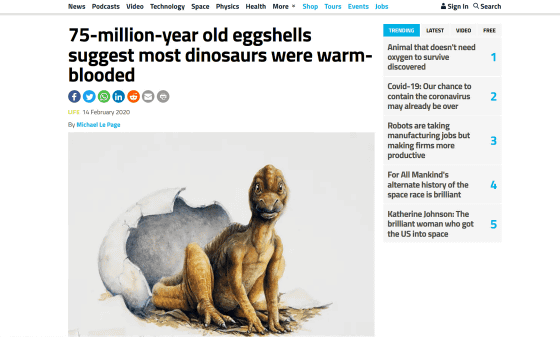Egg fossils suggest that dinosaurs may have had 'warm blood' flowing through them

by
Speaking of dinosaurs , there was an image of animals similar to reptiles such as Tyrannosaurus and Triceratops , but in recent years the theory that they are ancestors of birds is predominant. A new study analyzing dinosaur eggs raises the possibility that 'dinosaur blood is warmer than reptiles, whose body temperature is more sensitive to outside temperature, and has the ability to maintain a constant body temperature through metabolism.'
Eggshell geochemistry reveals ancestral metabolic thermoregulation in Dinosauria
https://www.science.org/doi/10.1126/sciadv.aax9361
Were dinosaurs warm blooded? Their eggshells say yes | YaleNews
https://news.yale.edu/2020/02/14/were-dinosaurs-warm-blooded-their-eggshells-say-yes
Dinosaur Eggshells Just Added Curious Evidence to a Debate About Their Blood
https://www.sciencealert.com/dinosaurs-were-warm-blooded-after-all-ancient-eggshell-fossils-suggest
75-million-year old eggshells suggest most dinosaurs were warm-blooded | New Scientist
https://www.newscientist.com/article/2233396-75-million-year-old-eggshells-suggest-most-dinosaurs-were-warm-blooded/

In general, mammals and birds whose body temperature can be raised by metabolism are called 'warm-blooded
Dinosaurs have long been considered to be animals whose body temperature is sensitive to the external environment, like reptiles, but as dinosaurs become more likely to be bird ancestors, they 'metabolize and heat like birds. Did you have the ability to raise it? ' However, until recent years, the method of investigating the body temperature of ancient creatures was only indirect, so it seems that detailed research on the body temperature of dinosaurs has not been conducted.
Therefore, the research team of American geophysicist Robin Dawson conducted a study to examine the body temperature of dinosaurs using 'dinosaur egg shells'. The research team used a method to determine the temperature at which the mineral was formed by examining the concentrations of the rare radioactive isotopes oxygen-18 and carbon-13 contained in the carbonate minerals. By applying this technique to dinosaur eggs, it is possible to know 'how much body temperature the mother dinosaur was when the egg was formed'.
The analysis used for this analysis was the ornithopoda Maiasaura and theropod Troodon , which lived in Canada about 75 million years ago, and the sauropod , which lived in Romania about 69 million years ago. It is a fossil of a small dinosaur egg that seems to be a Titanosauria .

by
As a result of the analysis, it was estimated that the body temperature of Maiasaura was 44 degrees Celsius, that of Troodon was 36 to 27 degrees Celsius, and that of Titanosaurus was 36 degrees Celsius. To compare the body temperature of the dinosaurs found in this way with the ambient temperature, the research team also estimated the temperature of the 'fossil invertebrate shell' found in the same place as the dinosaur egg. Since the body temperature of all invertebrates compared is easily affected by the outside, it can be said that the temperature of the invertebrate shell reflects the temperature of the surrounding environment.
Comparing the temperatures at which the dinosaur eggshells and invertebrate shells were formed, it was found that all dinosaur eggshells were formed at a temperature higher than the surrounding environment. Maiasaura was at least 15 degrees Celsius, Titanosauria was 3-6 degrees Celsius, and Troodon was 10 degrees Celsius, suggesting that all dinosaurs had warm blood. ..
An important point in this study is that the dinosaurs analyzed were groups of three major dinosaurs of different strains. It is unlikely that each strain has evolved to have warm blood independently, so it is possible that the common ancestors of dinosaurs had this characteristic. 'Our findings suggest that the ability of metabolism to raise body temperature evolved in early dinosaurs,' Dawson said.
The research team also pointed out that it is interesting that the size of the dinosaur's body is not necessarily related to the high body temperature. Dawson argued that feathers may have had an insulating role in the evolution of theropods.

by Gary Todd
Related Posts:







